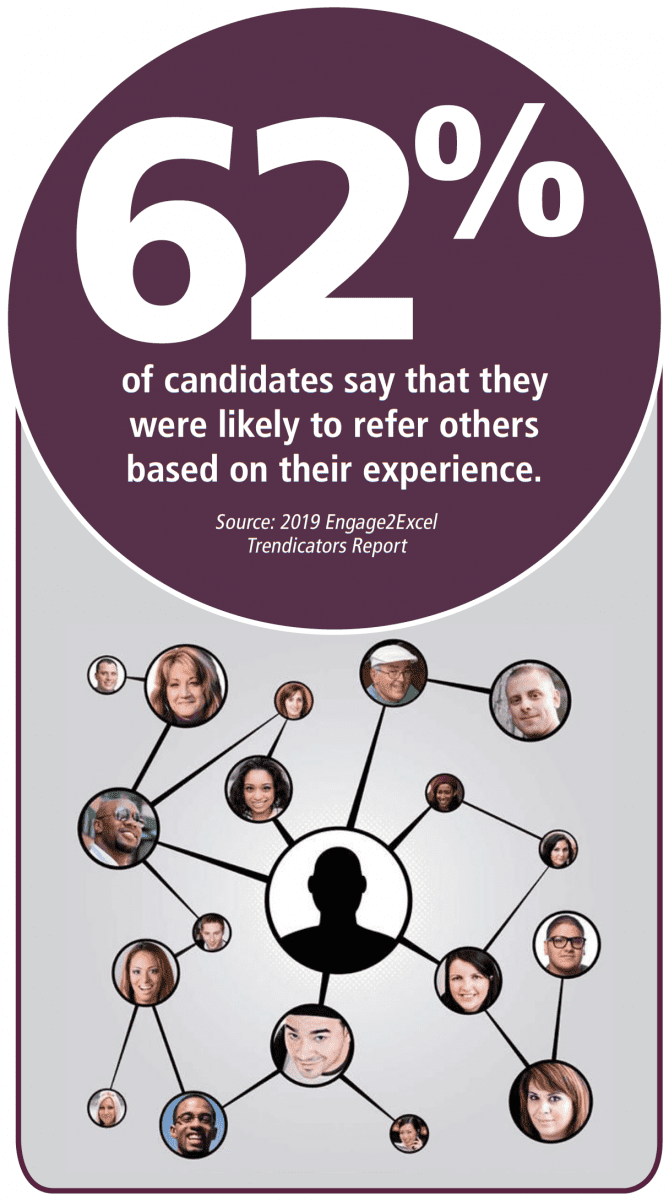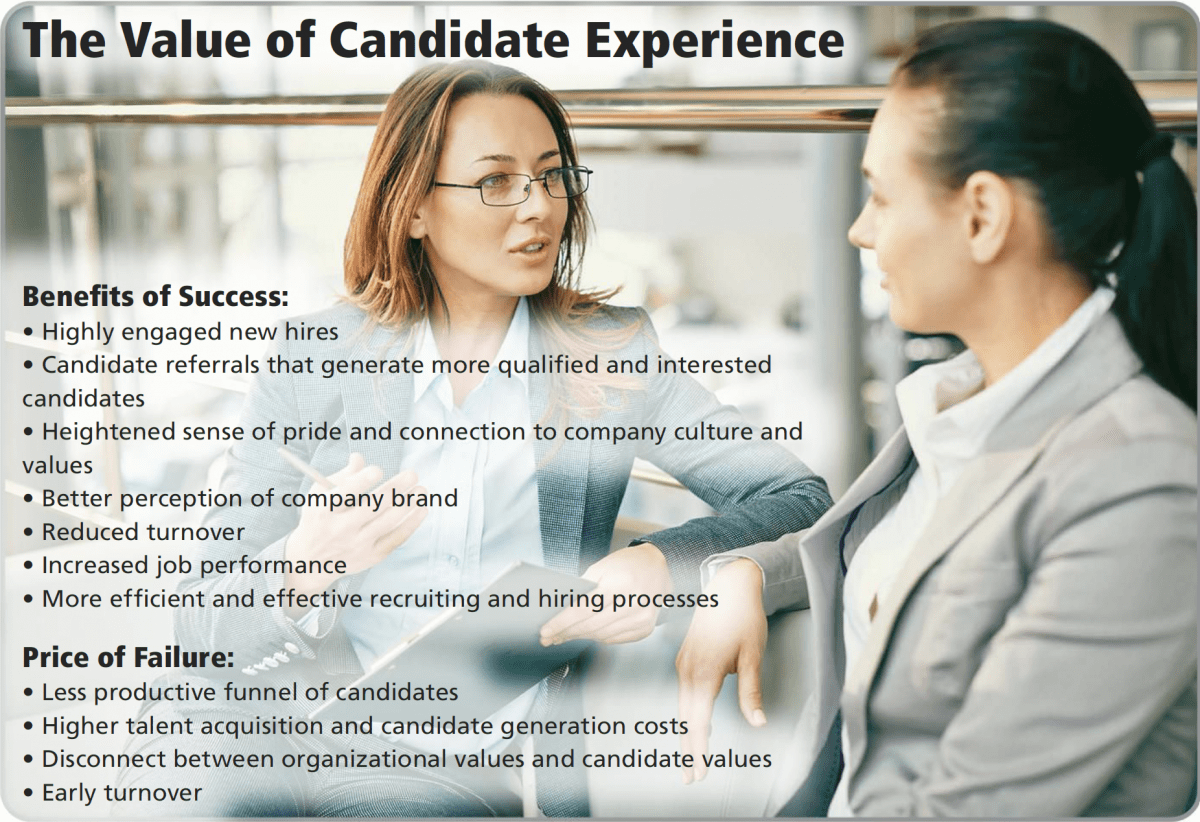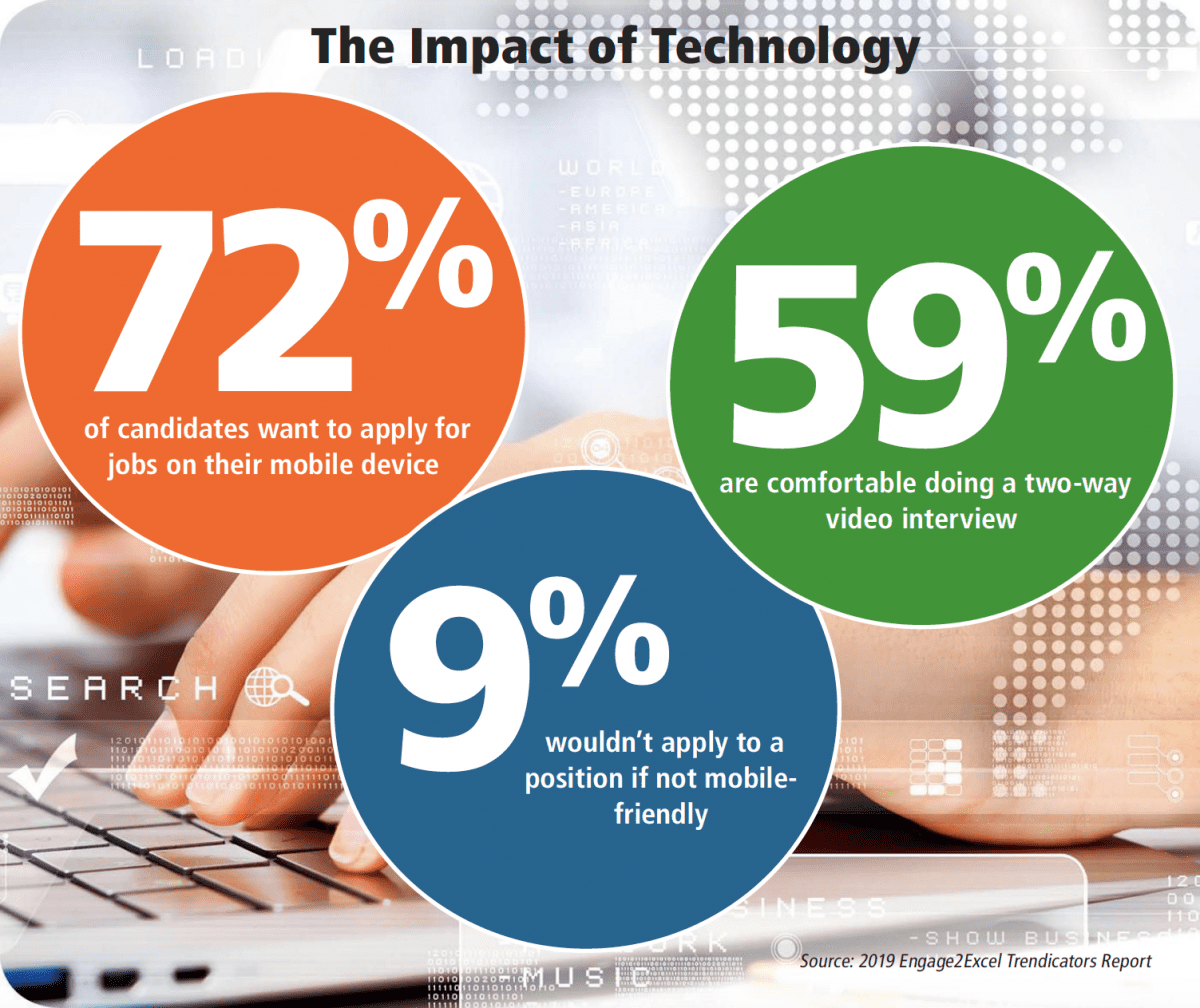Two organizations share insights into their successful tech-driven hiring processes that improve the candidate experience.
By Marta Chmielowicz
The outbreak of COVID-19 has forced much of the business world to make rapid changes to the way they operate, and organizations will to have continue to adapt as all industries enter a new normal post-pandemic. With the Federal Reserve anticipating an unemployment rate of 32 percent, continued restrictions around social distancing, and widespread economic instability, the hiring landscape for both businesses and job seekers will change dramatically.
“I think [the health crisis] is going to affect both sides of the hiring process,” says Marcy Maul, senior project director of Korn Ferry. “From the business side, it’s going to vary based on industry and segment, depending on the ability to continue operations in the virtual landscape. On the candidate side, even though we’re going to see rising unemployment, passive seekers will hesitate to make a change. There’s apprehension about giving up tenure and becoming the new person on the team. You’re going to see challenges on both sides -some due to regulations adapting to the new environment, and others due to the emotional impact on the individual.”
One constant that is likely to remain is the importance of a positive candidate experience. To reduce risk in an uncertain climate, organizations have the opportunity to leverage technology and tools to deliver a virtual hiring process that can produce equally effective results. Take, for example, Canada Life. The life insurance company has recently managed an end-to-end digital transformation, establishing a new virtual interview, documentation, and onboarding experience for its hiring team. According to Corey Shaw, assistant vice president of talent acquisition, the company’s success began with a strong foundation.
“It always starts with having a really strong baseline process that’s published and clear on the roles and responsibilities of the talent acquisition function,” he says. “We have a very clear governance and process, so we simply layered onto that process checkpoints to ensure that we’re going ahead with hires during COVID-19 and that the candidates have a comfortable virtual interview experience. We’re using the basics of Skype, FaceTime, and Microsoft tools, and encouraging hiring managers to use these tools. We’ve also updated our best practices guide for hiring leaders to ensure they deliver a comfortable virtual experience.”
 Automotive supplier Valvoline Inc. is also on the cutting edge, abandoning traditional hiring approaches to better align with social distancing guidelines and keep its plants, distribution centers, and stores operating.
Automotive supplier Valvoline Inc. is also on the cutting edge, abandoning traditional hiring approaches to better align with social distancing guidelines and keep its plants, distribution centers, and stores operating.
“Interviewing and hiring typically involved a lot of face-to-face interactions and handshakes, so our talent acquisition team designed a 100 percent online application, interviewing, and hiring process,” says Brandie Dawson, senior manager of global talent acquisition. “We are also facilitating virtual new hire orientation and onboarding for new hires who work in office positions. This approach not only protects the health of our current and future team members, it protects the communities where we live and work.”
While a pressing necessity drove organizations to transition to a virtual talent experience, many may experience additional benefits. According to an Engage2Excel Trendicators 2019 Job Seeker Survey Report:
- 72 percent of candidates want to apply for jobs on their mobile device;
- 9 percent wouldn’t apply to a position if not mobile-friendly; and
- 59 percent are comfortable doing a two-way video interview.
“In today’s labor market, pre-COVID-19 and after, there will continue to be a war for both talent and skills,” says Darren Findley, president of recruitment solutions at Engage2Excel. “With a positive candidate experience, you increase the level of engagement of candidates in the hiring and onboarding process, thus delivering a more engaged candidate and new hire. Sixty-two percent of candidates say that they were likely to refer others based on their experience, so a simple ROI on a positive experience will generate more qualified and interested candidates.”
Transforming the Candidate Experience
What steps can organizations take to ensure candidates have a positive experience during this uncertain time?
1. Adopt a data-driven approach. Data and analytics can offer insight into talent pipelines, helping organizations recruit best-fit talent. According to Shaw, HR leaders should examine their existing candidate pool to determine which roles they can fill internally before going to market.
His company leverages both internal and external data to build a talent plan that can support the business. Internally, the talent acquisition team looks at turnover and demographic data to determine where the workforce is growing, where it is contracting, and how it aligns with the broader business plan. From there, it collaborates with the senior leadership team to identify high-growth roles that require a stronger pipeline.
Externally, the Canada Life team uses LinkedIn Insights, a data warehouse tool, to stay abreast of industry trends and find where disruption is occurring among its competitors. By analyzing demographics and compensation, the data shows where talent exists and what is required to attract them.
Valvoline also relies heavily on data, with Dawson emphasizing that “what gets measured, gets better.” For example, the organization developed a predictive algorithm for the hiring of automotive technicians in its “Valvoline Instant Oil Change” service centers. By working with a partner to evaluate years of historical data on employee performance, the hiring team was able to identify 30 potential predictors of future on-the-job performance, which were then applied to the highest- and lowest-performing team members. The resulting analysis narrowed down the field to 12 predictive factors, including things like work ethic, learning mentality, service orientation, and process orientation, that were then integrated into the application experience via situational judgment scenarios.
“After months of hiring using this predictive algorithm, we were able to validate that the model was accurate,” Dawson says. “In fact, it proved to be far more predictive than we hoped for in our first round. We are now entering our second phase of this project -a period during which we will further refine the algorithm to be an even more accurate predictor of future success.”
Another way the company has leveraged analytics to select best-fit candidates is by running candidate funnel studies to identify where drop off occurs during the hiring process. Through these studies, Dawson’s team was able to define more consistent principles for assessing and hiring talent, which streamlined the entire process while reducing the potential for implicit bias.

2. Focus on communication to maintain a human touch. Today’s companies may need to adapt their hiring processes to follow social distancing guidelines, but that doesn’t mean the amount of overall communication has to change.
“Many firms believe that bringing people together fosters communication, and we’re at a time where enabling technology is key to allowing that to continue, not impact culture, and keep the workforce safe,” says Korn Ferry’s Maul.
With social distancing in mind, Maul says that companies can take advantage of various technologies to maintain connection within their teams and with external job seekers. For one, video interviewing tools like Skype or Zoom can give interviewers insight into non-verbal cues while keeping candidates at a safe distance. Microsoft Teams and other chat technologies can also bring people in different locations together in new ways, enabling dialogue across borders and eliminating the need for travel.
“Focusing efforts on communications and meeting candidates where they are -whether with chatbots, text capabilities, or community and social groups -to create a transparent candidate experience is critical,” agrees Findley.
These new technologies should be used to deliver timely and honest interactions between candidates, recruiters, and hiring managers throughout the entire hiring process. “The core of our candidate experience strategy is a solid communications plan, targeting every potential touch point with the candidate -from our careers site, job advertisements, online application, interview process, or communication with our team members to the job offer or rejection notice,” says Dawson.
For example, Canada Life’s recruitment team checks in with candidates after the first couple of weeks to let them know where they are in the process and alert them about next steps. Following a check-in with the hiring manager at week three, the team begins to screen and shortlist candidates. An artificial intelligence-enabled chatbot assists with this process for key roles, answering candidate questions and matching them with the position requirements. Those who meet the requirements are connected to a recruiter, and those who do not receive an automatic decline message.
According to Shaw, the company’s focus on communication even extends into the newly built virtual orientation session, where new hires are guided to speak with their talent acquisition advisor and a business leader who discusses the organization’s values. Using a combination of videos, PowerPoint presentations, and Microsoft Teams sessions, these virtual orientations introduce new hires to key leaders and enable them to feel a stronger connection with the organization.
Findley can attest to the efficacy of this approach. “Video interviews and, when possible, face-to-face relationship building with as many team members as possible will not only provide many insights into the organization, it will also create organizational relationships that can be leveraged during onboarding and early tenure to help new hires navigate your unique culture. A hiring manager’s participation in these efforts are critical.”

3. Evaluate and evolve. With COVID-19 showing how quickly times can change, organizations need to constantly evaluate their performance and determine areas of improvement.
Benchmarking against other experience-focused organizations is one reliable method to measure the perception of candidate experience. According to Findley, the Talent Board Candidate Benchmarking Survey is one useful tool that can help organizations compare their performance across industries.
Valvoline leverages this program to ensure that its strategies are paying off. “A true testimony that we’re focused on the right things is that through the CandE benchmarking program, 80-plus percent of candidates who completed a survey were not hired, yet happy with the Valvoline application and interview experience,” says Dawson.
Surveying candidates is another effective method to glean insight into the hiring experience. According to Shaw, every candidate who applies for a position at Canada Life -no matter whether hired or declined -is invited to do a seven- to eight-question candidate experience survey. This survey examines factors like:
- responsiveness of the recruiter;
- ease of technology use;
- quality of the interview experience;
- depth of recruiter knowledge about the role;
- frequency of check-ins throughout the process; and
- quality of first day experience.
Each question’s performance is ranked on a five-point scale, revealing gaps in experience that can be targeted by the talent acquisition team. For best results, Maul recommends that organizations develop surveys that categorically evaluate all the different parts of the hiring process, from technology to engagement with the hiring manager. “If you’re leveraging a survey, you need to structure it to pinpoint which of those elements was the weak point,” she says.
But she emphasizes that it’s also important to speak with new hires in onboarding interviews, evaluating the variables that led to their decision to join the organization and what they appreciated most about the process.
“We do exit interviews when people leave a new company, but there’s a missed opportunity to not do onboarding interviews,” Maul explains. “Hiring leaders should reengage with their new hires 60 to 90 days into the role to really measure how effectively they portrayed the job in the hiring process. Now that they’re functioning and settled in, did the organization outline the position and culture correctly? These are important elements not only for hiring but also employee experience. The goal is to drive retention -and that’s something that needs to be measured.”














